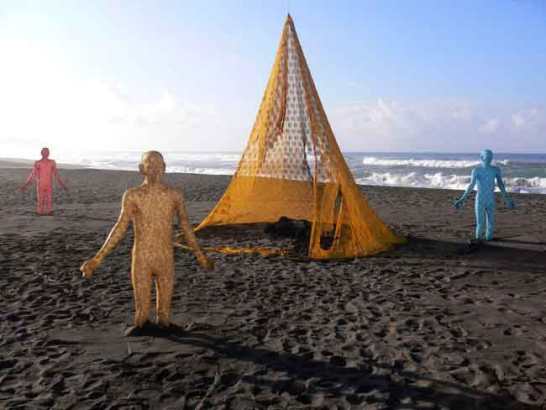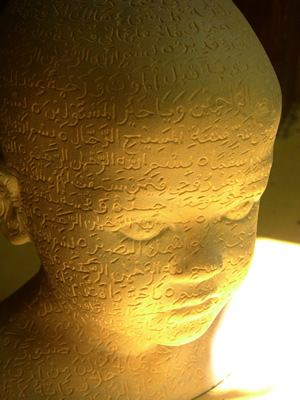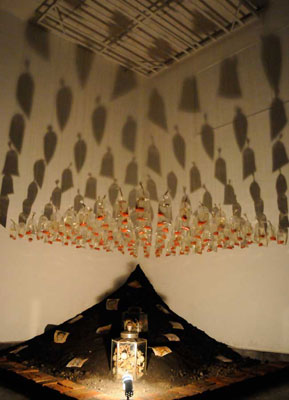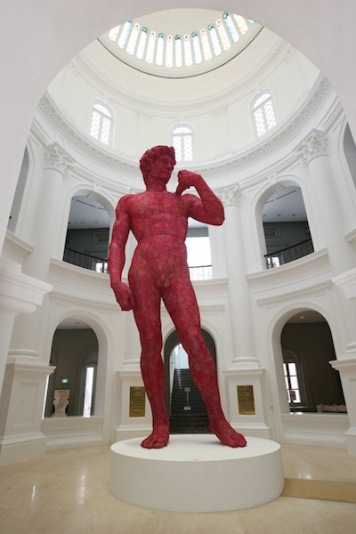Wulan Dirgantoro
Despite the author’s concerns about the reception of the work Singaporean audiences loved 'Surrounding David' Courtesy of the artist
In 2008, visitors to the National Museum of Singapore were presented with a novel spectacle. Singapore’s art crowd is familiar with all kinds of contemporary art, but this was truly monumental, both literally and metaphorically. Entering the museum from the front door, visitors saw a giant pair of male legs in the familiar contrapposto position. Entering the rotunda of the museum, they would have recognised the work: it was a giant replica of Michelangelo’s famous sculpture David. However, the sculpture was 850 centimetres tall, nearly twice the height of the original sculpture and moreover, it was clad in skin-tight, neon-pink, floral brocade.
Surrounding David is an ambitious work from one of Indonesia’s prominent female artists, Titarubi. Born in Bandung in 1961, she completed her tertiary education in the Faculty of Fine Art and Design at the Bandung Institute of Technology in 1997, majoring in Ceramics. Currently residing in Yogyakarta, Titarubi is the co-founder and co-director of iCAN (Indonesian Contemporary Art Network), an arts management company whose projects reflect her diverse interests, from organising visual arts exhibitions and art residencies, to holding dance performances.
Traversing boundaries
She has also worked across disciplines, notably with the film director, Garin Nugroho in Opera Jawa (2009) and Fitri Setyaningsih, a notable Indonesian female choreographer, in a three-part dance performance entitled Selamat Datang dari Bawah (Welcome From Below, 2010). Tita, as she is colloquially called, worked as collaborator and artistic director in both these projects. But apart from her diverse artistic explorations, she is also known for her ongoing commitment to addressing gender issues in her works, most importantly through representations of the body.
Within Indonesia’s predominantly male art scene, female artists often face hurdles which are rarely encountered or even acknowledged by their male contemporaries. There is certainly no lack of talent amongst Indonesia’s women artists, but the careers of many talented Indonesian women artists have been impeded by deeply-rooted attitudes about the artistic life. These include gender expectations, the stigma of wildness or Bohemianism that inheres to the profession, and the financial instability that is commonly associated with it.
Even though the situation is now improving, with more female art graduates pursuing careers as professional artists, women who are heavily involved in the art scene often work behind the scenes as managers, and increasingly, as curators, gallery owners and collectors. But the public face of the Indonesian art world remains decidedly male.
This situation does not go unnoticed by women artists themselves. Many art projects, exhibitions and publications have been created by Indonesian women artists to address and challenge the gender bias in Indonesian art world, with varying degree of success. Titarubi is foremost among a group of women artists whose works have been able to simultaneously critique the masculine conventions of art-making and give expression to a distinct female subjectivity. This has recently come through strongly in her ‘political motherhood’ projects.
Attack of the brocade army
Exploring the body has emerged as a form of social, political and personal critique for many Indonesian women artists. Titarubi’s exploration of the intersections of art, medium and masculinity started in 2005 when she participated in the infamous CP Biennale 2005 Urban/Culture. Indonesia’s second international biennale was notorious for the controversy surrounding the installation Pink Swing Park. The installation featured Indonesian soap opera stars Anjasmara and Isabel Jahja in the nude within a post-apocalyptic garden. The ensuing media frenzy attracted the attention of Islamic hardliners, closed down the biennale, and ended with the artists (Agus Suwage and Davy Linggar), their models and the biennale organisers facing charges in court.
 Vagina Brokat tells the story of Shinta’s sacrifice in the Ramayana epic Courtesy of the artist
Vagina Brokat tells the story of Shinta’s sacrifice in the Ramayana epic Courtesy of the artist
Her installation for the biennale, Bodyscape (fibreglass, brocade, light, 2005) was a critique of the masculine image in art. In the first manifestation of this evolving installation, the artist subverted the conventions of the sculptural representation of the male figure. Bronze or marble are traditionally used to emphasise masculinity in Indonesian sculpture, but in this installation the artist covered the male figures entirely in brocade.In Indonesia, brocade symbolises femininity, especially because of its use in the traditional blouse (kebaya).
Titarubi also used brocade in her collaboration with Garin Nugroho and Fitri Setyaningsih. A later piece, Vagina Brokat (Brocade Vagina) told the story of Shinta’s sacrifice in the Ramayana epic. The artist placed the male figures around a gold brocade tent, burying them up to their knees, a move which symbolically weakened their masculine power. Surrounding David is perhaps the culmination of her preoccupation with this theme. By deliberately enlarging such an iconic sculpture, the artist was able to emphasise the naked maleness of this renowned body, while at the same time feminising it with the pink floral brocade.
 Bayang-bayang Maha Kecil (Shadows of the Tiniest Kind) places women’s ‘private domain’ into public space Courtesy of the artist
Bayang-bayang Maha Kecil (Shadows of the Tiniest Kind) places women’s ‘private domain’ into public space Courtesy of the artist
One reviewer described Surrounding David as ‘breathtaking’, not only because of its sheer size, but also because it managed to delight so many Singaporeans. A conservative attitude towards nudity and political art prevails in Singapore, yet school groups and even bible groups were spotted taking happy snaps beside the sculpture. Clearly, there was no problem with nakedness here, even though the body’s genitalia, ‘covered’ in pink fabric, were more or less hanging above visitors’ heads.
Nonetheless, the artist was also aware of the possibility of censorship from the Singaporean government. So Tita prepared a leaf cover, similar to the leaf used in classical Renaissance paintings, to cover the penis. But instead of using a fig leaf, as the classical norm dictates, she used a papaya leaf. She stated cheekily that papaya leaf is traditionally used to soften meat in cooking. The cover however, was never used throughout the five month duration of the show.
Political motherhood
When the Asian financial crisis hit Indonesia in late 1997, the effect was devastating. Prices rose dramatically as the New Order government failed to control the economy. The value of the rupiah plummeted. Students began demonstrating, and other urban Indonesians took to the streets to protest alongside them.
Titarubi was heavily involved in the 1998 protests. She provided support for the activists and created performance art in support of the demonstrations. Shaped by her earlier participation in various social and cultural movements, and by her own experience as a mother of two girls, she began to introduce themes of political motherhood into her work.
These themes emerged in the work she made in support of the movement called SIP or Suara Ibu Peduli (Voice of the Concerned Mothers). This was a politicised statement on behalf of motherhood, the likes of which had not been seen since the days of high inflation and political turmoil in the 1950s and 1960s. The women behind SIP started with a focus on the failure of the state to support mothers in providing for their families, highlighting the rapidly rising prices of goods and services. The group’s activists organised funding to provide women with half-price milk-powder, an item that was then in short supply and skyrocketing in price.
 Missing and Silent commemorates missing activists from a mother’s perspective Courtesy of the artist
Missing and Silent commemorates missing activists from a mother’s perspective Courtesy of the artist
Critics of SIP stated that it was essentially a movement of middle-class women, for only they could afford milk-powder for babies and pregnant mothers. Furthermore, critics objected to the use of the ‘ibu’, or mother, persona in the movement, arguing that it was used to promote New Order ideology that subjugated women.
And yet, supporters of the group firmly believed that the use of the ‘ibu’ persona was important to emphasise the peaceful nature of the movement, and to create a contrast with the heavy-handed militarism of the time. In May 1998, when SIP raised the issue of student activists who were missing, abducted by the military, Titarubi began to create works which both directly and indirectly referenced this situation.
Representing the disappeared
Missing and Silent is an installation piece consisting of an arrangement of ceramic figurines in the form of foetuses, juxtaposed with photos of the disappeared activists. In the first version of the installation, the small foetuses made of earthenware were placed on top of illuminated boxes covered by earthenware bricks. The photos were placed around the sides of the base. There were no direct connections between the individual figurines and the photographs. The figurines appeared to have been strewn carelessly by the artist, and this random arrangement in fact emphasised the fragility of the figurines.
In the 2010 version of the installation, the artist recreated the foetuses in even smaller dimensions. The figurines were made from red wax, and were placed within transparent plastic bags filled with water. The bags were hung above black soil in which the artist placed photographs of the missing activists and glass jars filled with earthenware figurines. The installation evoked a strong sense of loss, but perhaps more importantly, the loss was expressed from a mother’s perspective.
Titarubi’s works reflect the ambiguity arising in politicised representations of motherhood in Indonesia. As a mother and artist, Titarubi is continuously exploring the tensions of motherhood, such as in her famous installation Bayang-bayang Maha Kecil (Shadows of the Tiniest Kind, ceramics, mixed media, 2002-2004). The political messages in such works are strongly stated, but are expressed through the perspective of the mother. In this way, the artist has placed women’s ‘private domain’ into the wider discourse of public space. Tita is attempting to redefine notions of the Indonesian domestic sphere, while also opening up a discursive space on female subjectivity in Indonesia.
Wulan Dirgantoro (Wulan.Dirgantoro@utas.edu.au) is currently writing her PhD thesis at the University of Tasmania on the artist’s body in Indonesian contemporary art.
